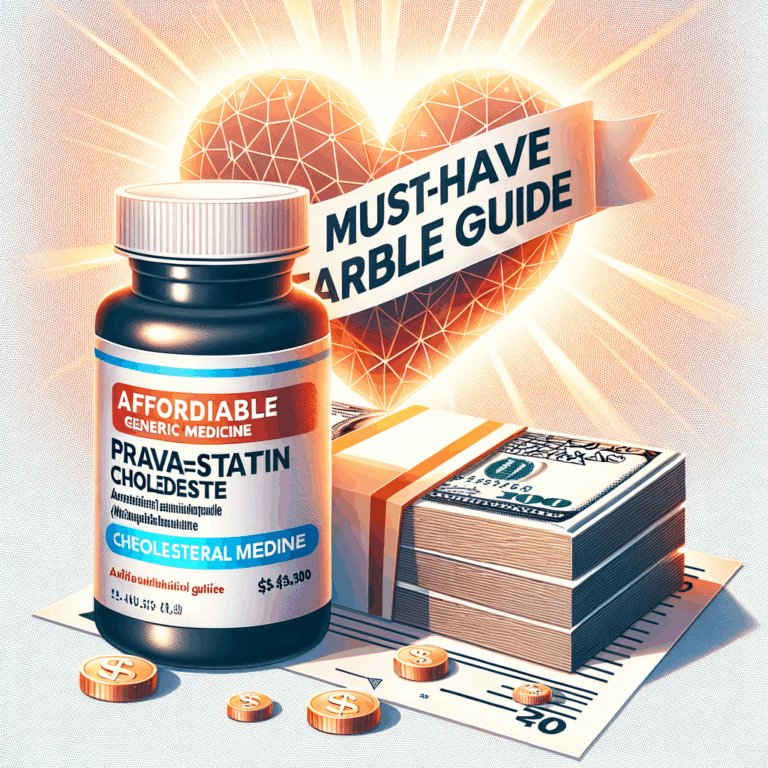
- Introduction: Why Lisinopril Matters for Blood Pressure
- What Is Lisinopril?
- How Lisinopril Works: The Science in Simple Words
- Key Benefits of Lisinopril for Blood Pressure
- Benefit: Effective Blood Pressure Control
- Benefit: Heart Protection After a Heart Attack
- Benefit: Kidney Protection for Diabetic Patients
- Who Should Consider Lisinopril?
- When Lisinopril Is a Good Match
- When to Avoid Lisinopril
- Dosage, Forms, and How to Take It
- Common Dosage Guidelines
- Storage and Safety Tips
- Side Effects and How to Manage Them
- Common Side Effects
- Serious Side Effects to Watch For
- Interactions: What to Avoid While Taking Lisinopril
- Common Interactions
- Monitoring and Follow-Up
- What Your Doctor Will Check
- Tips to Maximize Lisinopril Benefits
- Practical Daily Tips
- Comparing Lisinopril to Other Blood Pressure Meds
- Lisinopril vs. ARBs (e.g., Losartan)
- Lisinopril vs. Beta Blockers and Others
- Special Populations: Older Adults, Pregnant Women, and Children
- Older Adults
- Pregnancy and Children
- Real-World Results and Patient Stories
- Cost, Access, and Generic Options
- Ways to Save on Lisinopril
- When to Talk to Your Doctor
- Summary: Why Lisinopril Offers Stunning Relief
- Quick Reference Table: Uses, Typical Dose, and Key Warnings
- Common Questions People Might Still Have
- Can I stop taking Lisinopril once my blood pressure is normal?
- How long until Lisinopril takes effect?
- Can Lisinopril cause weight gain?
- Is Lisinopril safe with other heart drugs?
- What if I get a dry cough?
- FAQs
- References
Introduction: Why Lisinopril Matters for Blood Pressure
High blood pressure affects millions around the world. Left unchecked, it increases risk for heart attack, stroke, and kidney disease. Consequently, people look for treatments that work reliably and safely.
Lisinopril stands out as a common first-line drug for high blood pressure. In this article, I explain Lisinopril blood pressure benefits in clear, simple terms. I also cover how it works, who should take it, side effects, and practical tips to get the most benefit.
What Is Lisinopril?
Lisinopril belongs to a class of drugs called ACE inhibitors. Doctors prescribe it to lower blood pressure and help the heart pump more efficiently. It also helps people who had a heart attack recover faster.
Lisinopril prevents the body from making angiotensin II. This chemical narrows blood vessels. As a result, vessels relax and blood pressure falls. The drug also reduces strain on the heart and improves blood flow.
How Lisinopril Works: The Science in Simple Words
Your body produces angiotensin II to tighten blood vessels when needed. Lisinopril blocks the enzyme that creates angiotensin II. When angiotensin II drops, vessels open and pressure goes down.
Furthermore, Lisinopril helps lower extra fluid in the body. It reduces the workload on your heart. Over time, this can protect your organs and improve overall health.
Key Benefits of Lisinopril for Blood Pressure
People use Lisinopril for many reasons. Primarily, it lowers systolic and diastolic blood pressure. This reduces the chance of dangerous events like stroke and heart attack.
Additionally, Lisinopril helps protect the kidneys in people with diabetes or protein in the urine. For those with heart failure, it can improve symptoms and reduce hospital stays. Overall, it offers both immediate and long-term benefits.
Benefit: Effective Blood Pressure Control
Clinics often choose Lisinopril for reliable blood pressure control. Many patients reach target numbers with it. When combined with lifestyle changes, results improve further.
Doctors also pair Lisinopril with other drugs when needed. That approach offers a flexible way to reach goals without excessive side effects.
Benefit: Heart Protection After a Heart Attack
After a heart attack, the heart needs help to heal. Lisinopril reduces stress on the heart muscle. Consequently, patients often recover better and faster.
Studies show fewer deaths and fewer repeat hospital stays among users. Therefore, doctors commonly include Lisinopril in post-heart-attack care plans.
Benefit: Kidney Protection for Diabetic Patients
Diabetes can damage kidneys over time. Lisinopril helps by lowering pressure inside kidney filters. As a result, it slows kidney damage and reduces protein loss in urine.
Because of this effect, many nephrologists recommend Lisinopril for diabetic patients. It provides a clear, evidence-based way to protect kidney function.
Who Should Consider Lisinopril?
Doctors typically prescribe Lisinopril to adults with high blood pressure. They also recommend it after a heart attack or for people with heart failure. Additionally, it helps diabetic patients with early signs of kidney injury.
However, some people should avoid Lisinopril. Pregnant women, for example, must not take it. Likewise, people with a history of angioedema linked to ACE inhibitors should avoid it. Always consult your healthcare provider first.
When Lisinopril Is a Good Match
You might get Lisinopril if lifestyle changes alone do not lower your blood pressure. Also, if you have diabetes with protein in your urine, Lisinopril may protect your kidneys. Many older adults also tolerate it well when dosed correctly.
Your doctor will review your medical history and current medications. This step ensures that Lisinopril fits your needs and reduces risks.
When to Avoid Lisinopril
Avoid Lisinopril during pregnancy. The drug can harm the fetus and cause serious birth defects. Also, do not take Lisinopril if you have a history of severe allergic reactions to ACE inhibitors.
If you have very low blood pressure, severe kidney disease, or high potassium levels, your doctor may choose another drug. Therefore, proper medical screening is essential before starting Lisinopril.
Dosage, Forms, and How to Take It
Lisinopril comes in tablet form. Doctors prescribe doses based on the condition and patient response. Typical starting doses range from 5 mg to 10 mg daily. Clinicians may increase doses slowly to reach target blood pressure.
Take Lisinopril once daily at the same time. You can take it with or without food. Drink water with the pill to reduce throat irritation risk. Never split tablets unless your provider says it’s okay.
Common Dosage Guidelines
– For high blood pressure: Typical starting dose 10 mg once daily. Maintenance dose 20–40 mg daily.
– After heart attack: Lower starting doses, such as 5 mg, then adjust.
– For heart failure: Often 2.5–5 mg to start. Clinicians increase as tolerated.
These numbers serve as general guidance. Always follow your doctor’s instructions precisely.
Storage and Safety Tips
Store Lisinopril at room temperature away from heat and moisture. Keep it in its original bottle. Also, keep it out of reach of children.
If you miss a dose, take it as soon as you remember. However, skip it if it is almost time for your next dose. Do not double up to catch up.
Side Effects and How to Manage Them
Like all medicines, Lisinopril can cause side effects. Common ones include cough, dizziness, and tiredness. Most side effects appear early and lessen over time.
A dry, persistent cough affects some people. If the cough becomes bothersome, talk to your doctor. They may switch you to another class of drugs called ARBs. Serious effects like swelling of the face or throat (angioedema) require immediate medical attention.
Common Side Effects
– Dry cough
– Lightheadedness or dizziness
– Fatigue
– Headache
– Nausea
These side effects often resolve as your body adjusts. Also, staying hydrated and rising slowly from sitting can help with dizziness.
Serious Side Effects to Watch For
– Swelling of face, lips, tongue, or throat
– Trouble breathing
– Very low blood pressure
– High potassium levels (symptoms: muscle weakness, irregular heartbeat)
– Kidney problems (changes in urine)
Seek emergency help for any breathing issues or severe swelling. For other concerns, call your healthcare provider quickly.
Interactions: What to Avoid While Taking Lisinopril
Lisinopril can interact with many drugs and supplements. Combining it with potassium supplements or potassium-sparing diuretics may raise potassium levels. High potassium can be dangerous, so your doctor will monitor blood tests.
Nonsteroidal anti-inflammatory drugs (NSAIDs) like ibuprofen may reduce Lisinopril’s effect. Additionally, some diuretics might increase the chance of low blood pressure when started together. Always tell your doctor about all medicines you use.
Common Interactions
– Potassium supplements and salt substitutes
– Potassium-sparing diuretics (spironolactone, triamterene)
– NSAIDs (ibuprofen, naproxen)
– Other blood pressure medicines, especially at start of therapy
– Lithium
Your provider will adjust treatments to avoid harmful interactions. Regular lab checks help catch issues early.
Monitoring and Follow-Up
When you start Lisinopril, your clinician will schedule follow-up visits. They will check blood pressure and blood tests. Tests often include kidney function and potassium levels.
Monitoring helps find side effects early. It also ensures the drug works well for you. If needed, your provider will change the dose or try a different medicine.
What Your Doctor Will Check
– Blood pressure readings
– Serum creatinine and estimated glomerular filtration rate (eGFR)
– Blood potassium levels
– Symptoms like cough or dizziness
Frequent checks occur in the first weeks. Later, the visits may space out to every few months.
Tips to Maximize Lisinopril Benefits
Combine Lisinopril with healthy lifestyle changes. Eat a balanced diet low in salt. Exercise regularly and aim for weight loss if needed. These steps help medications work better.
Also, take your medication at the same time daily. Use a pillbox or phone reminder. Finally, keep a home blood pressure log. Share it with your doctor during visits.
Practical Daily Tips
– Measure blood pressure at the same time each day.
– Avoid sudden standing to reduce dizziness.
– Limit alcohol, which can increase blood pressure.
– Speak to your doctor before starting new supplements.
These small steps can make a big difference for your treatment results.
Comparing Lisinopril to Other Blood Pressure Meds
Lisinopril belongs to ACE inhibitors, which differ from ARBs, beta blockers, and calcium channel blockers. Each class works differently and has unique side effects. Doctors pick drugs based on health history and how the patient responds.
Compared to ARBs, ACE inhibitors cause cough more often. Yet, both protect kidneys and lower blood pressure effectively. Some patients benefit more from one class than another, so testing helps find the right fit.
Lisinopril vs. ARBs (e.g., Losartan)
– Mechanism: ARBs block angiotensin II receptors; ACE inhibitors block its formation.
– Side effects: ARBs cause less cough. Angioedema risk remains low in both.
– Use: Both help with kidney protection in diabetes.
If cough becomes intolerable, doctors often switch ACE inhibitors to ARBs.
Lisinopril vs. Beta Blockers and Others
– Beta blockers reduce heart rate and may help conditions like arrhythmia.
– Calcium channel blockers help people with isolated high systolic pressure.
– Diuretics lower blood volume to reduce pressure.
Often, doctors use two or more types for better control. Combination therapy can bring better results with lower doses.
Special Populations: Older Adults, Pregnant Women, and Children
Older adults often tolerate Lisinopril well when doctors start low and go slow. Yet, they may face more dizziness and kidney changes. Regular labs and careful dose adjustments help keep them safe.
Pregnant women should not take Lisinopril due to risk to the fetus. Women planning pregnancy must switch to safer options. Pediatric uses exist, but dosing requires careful medical oversight.
Older Adults
Start with low doses and monitor closely. Watch for falls due to dizziness. Also, evaluate kidney function more often.
Many older patients gain heart and kidney benefits. Still, providers must adjust therapy based on individual risks.
Pregnancy and Children
Never take Lisinopril during pregnancy. It can harm the developing fetus. If you plan pregnancy, discuss safer alternatives with your provider.
For children, doctors may prescribe Lisinopril in specific scenarios. Pediatric dosing varies by weight and condition. Always follow specialist guidance.
Real-World Results and Patient Stories
Many people report marked improvements with Lisinopril. They often notice lower blood pressure readings within weeks. Some patients also feel less shortness of breath in heart failure.
However, personal experiences vary. Some patients switch due to cough or other side effects. Overall, Lisinopril remains a trusted option in many care plans.
Cost, Access, and Generic Options
Generic Lisinopril offers a cost-effective option. It typically costs much less than brand-name drugs. Most insurance plans cover generic forms, too.
If cost remains a barrier, ask your doctor or pharmacist about coupons or assistance programs. Also, many pharmacies offer discounted generic drug lists.
Ways to Save on Lisinopril
– Use generic Lisinopril instead of brand name.
– Check your pharmacy for discount programs.
– Ask prescribers about patient assistance programs.
– Compare prices at different pharmacies.
These steps can reduce monthly drug costs while keeping treatment consistent.
When to Talk to Your Doctor
Contact your provider if you notice severe side effects. Also, reach out if your blood pressure remains high despite taking medicine. Changes in urine, persistent cough, or swelling deserve quick attention.
Finally, tell your doctor if you plan to become pregnant. Your provider will review safer alternatives. Regular communication keeps treatment safe and effective.
Summary: Why Lisinopril Offers Stunning Relief
Lisinopril provides reliable blood pressure control for many people. It protects the heart and kidneys in numerous conditions. The drug stands out for its proven benefits and wide clinical use.
Nevertheless, Lisinopril can cause side effects and interactions. With proper monitoring and lifestyle changes, most people gain significant benefit. Talk with your healthcare provider to decide if Lisinopril fits your care plan.
Quick Reference Table: Uses, Typical Dose, and Key Warnings
| Use | Typical Starting Dose | Key Warnings |
|---|---|---|
| High blood pressure | 10 mg once daily | Avoid in pregnancy; watch potassium and kidney function |
| Heart failure | 2.5–5 mg once daily | Monitor blood pressure and renal labs |
| Post-heart attack | 5 mg then adjusted | Start low; watch for low blood pressure |
| Kidney protection (diabetes) | 10 mg then adjusted | Check urine protein and renal labs |
Common Questions People Might Still Have
Can I stop taking Lisinopril once my blood pressure is normal?
Do not stop without medical advice. Suddenly stopping can raise blood pressure. Your doctor may lower the dose gradually if needed.
How long until Lisinopril takes effect?
You may see lower blood pressure within an hour. Full effects often appear after 2–4 weeks. Your doctor will monitor progress and adjust dose.
Can Lisinopril cause weight gain?
Lisinopril does not typically cause weight gain. However, fluid changes in heart failure may affect weight. Discuss any weight changes with your provider.
Is Lisinopril safe with other heart drugs?
Often yes, but interactions can occur. Your provider will choose safe combinations and monitor labs. Always list all drugs you take.
What if I get a dry cough?
Tell your doctor. They may switch you to an ARB like losartan. Many patients find relief after switching.
FAQs
1) Is Lisinopril the best first choice for everyone with high blood pressure?
– No. Doctors individualize therapy. They consider age, race, other conditions, and drug tolerance.
2) Can I drink alcohol while taking Lisinopril?
– Moderate alcohol may be safe, yet it can increase dizziness. Ask your provider for personalized advice.
3) How often should I check my kidney function on Lisinopril?
– Doctors usually check within 1–2 weeks of starting. Later, they check every 3–6 months, depending on risk.
4) Can Lisinopril cause depression or mood changes?
– These effects are rare. Report persistent mood changes to your provider for evaluation.
5) Does Lisinopril interact with herbal supplements?
– Some herbal products, like potassium supplements, can interact. Always inform your doctor about supplements.
6) Will Lisinopril affect my sexual function?
– Sexual side effects are uncommon. If you notice changes, discuss them with your provider.
7) Can breastfeeding mothers take Lisinopril?
– Lisinopril can pass into breast milk. Discuss risks and alternatives with a healthcare provider.
8) What should I do if I experience angioedema?
– Seek emergency care immediately. Angioedema can become life-threatening.
9) How does Lisinopril affect blood sugar?
– Lisinopril does not usually raise blood sugar. It may help protect kidneys in diabetes care.
10) Can I take Lisinopril if I have asthma?
– Yes, generally. Lisinopril does not worsen asthma. However, monitor any cough or breathing changes.
References
– American Heart Association — ACE Inhibitors: What You Need to Know. https://www.heart.org/en/health-topics/high-blood-pressure/changes-you-can-make-to-manage-high-blood-pressure/ace-inhibitors
– National Institutes of Health — Lisinopril Monograph. https://pubmed.ncbi.nlm.nih.gov/
– Mayo Clinic — Lisinopril (Oral Route). https://www.mayoclinic.org/drugs-supplements/lisinopril-oral-route/description/drg-20071140
– American Diabetes Association — ACE Inhibitors and Kidney Protection. https://diabetes.org/diabetes/medication-management/blood-pressure
– UpToDate — Use of ACE inhibitors after myocardial infarction. (Subscription required) https://www.uptodate.com/contents/
Note: This article offers general information and does not substitute medical advice. Talk with your healthcare provider before starting or changing any medication.



